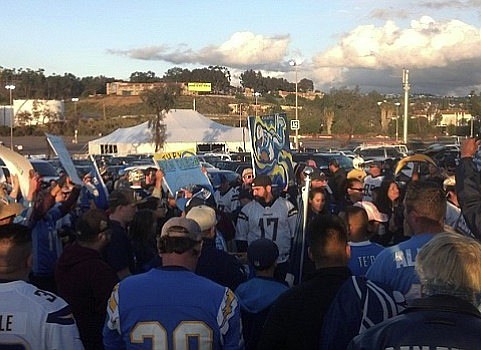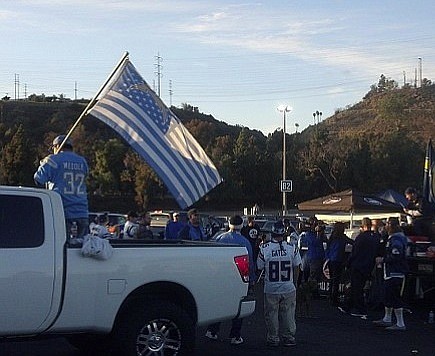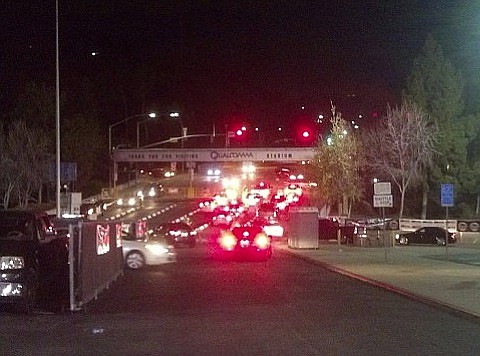 Facebook
Facebook
 X
X
 Instagram
Instagram
 TikTok
TikTok
 Youtube
Youtube

Thousands of San Diegans showed up to party, tailgate, and generally show their support for the city's football team before a Monday-evening public forum put on by a new stadium advisory group organized by mayor Kevin Faulconer. The information-gathering session itself, however, failed to capture the enthusiasm of much of the crowd, and concluded a half-hour short of its advertised three-hour run time.



Fans crowded the parking lot well before the meeting's 6 p.m. start time, breaking out barbecues, coolers full of beer and lawn chairs, tailgating as if preparing for a Monday-night football game in March. Chants of "Save Our Bolts!" broke out across the lot, led at one point by recently retired Chargers center Nick Hardwick. The slogan has become local football fans' rallying cry and has spawned a website of the same name run by fans dedicated to drumming up support for a new stadium.
Seating capacity in the lounge where the meeting took place was limited to the first 400 through the gates — it filled within minutes. A line snaked around the side of the stadium and eventually grew to include over 250 people by the time 5:30 approached. The game-day atmosphere continued inside, as security guards did pat-down inspections before allowing attendees through the turnstiles, where they were met by radio-station promotional booths and a long line to purchase $9 burritos from a food truck parked by an escalator.
With the meeting room packed, overflow crowds in excess of 2000 packed into general seating areas, where the cheers and chants continued, frequently drowning out parts of the testimony of speakers. The volume initially increased as additional sections of seating were opened near the west end zone for the particularly boisterous late arrivals who'd waited too long to get through security.
The meeting was to be conducted as an information-gathering session — advisory group members did not field questions but asked specifically for input on preferred locations for a new stadium and potential financing plans. Each topic was to be given 90 minutes' consideration, with each speaker getting a maximum 90-second allotment.
Many of the speakers were less interested in responding to these questions than proclaiming their fanhood, however; many stated the number of years they'd been attending games or offered emotional anecdotes related to their affection for the team. Most of these stories were met with more loud cheers and applause in the overflow section.
"Put it in my backyard if you want, as long as we don't have to share it with the Raiders," offered one fan, a popular sentiment among the off-topic commenters and most of the crowd.
Of the attendees who did speak on the location issue, most were convinced that the existing stadium site in Mission Valley was the best location for a new stadium. They repeatedly emphasized the importance of tailgating, which would be lost by moving the stadium downtown, the only other proposed site that has been getting significant consideration. Qualcomm Stadium’s 100-acre parking lot is a huge selling point for fans.
"If you build downtown, you're not going to have the parking or accessibility we have down there," said Ken Chandler, vice president of the Charger Backers fan club. "I've been a season ticket holder for 32 years, a lot of them bad years — the only thing that kept me coming back is the eight or ten times a year I've been able to tailgate with my friends."
“Tailgating is where it's at! You took away [legal alcohol consumption at] the beach; don't take away our tailgating," pleaded a young fan following Chandler.
What none of the existing-site backers mentioned with regard to the tailgating issue is the fact that most of the plans put forth for the Mission Valley site include removing most of the on-site parking and replacing it with new construction, including the one officially endorsed by the Chargers in 2006.
Several speakers who claimed to have inside knowledge indicated that the team's strong preference is to focus instead on a site downtown, despite opposition from hoteliers and other convention-center-expansion backers who believe a proposal to link a new stadium to expanded convention space is a non-starter due to its placement several blocks from the existing center and news from the Metropolitan Transit System that it could take five to seven years to vacate the site near Petco Park that's being eyed for a new facility.
"I've been in direct communication with the Chargers on a regular basis," said Dan McLellan, communications director with Save Our Bolts. "I can tell you with absolute certainty that their preference is downtown, and they have a financially feasible plan that would be outstanding for the city of San Diego."
McLellan didn't go into specifics but suggested the plan revolved around raising hotel taxes as a revenue source for the city to fund construction. He also pledged his group's support in pushing through any ballot initiative that might be put before voters.
"When you come up with a plan that's feasible, we'll become the campaign backers to make sure that it passes."

As the meeting passed the 30-minute mark, some late-comers continued to make their way inside, though a steady stream of fans departing outnumbered them by a five-to-one margin. A check on the parking lot found a steady stream of cars heading for the exits, while others resumed their tailgating (or never stopped, following the pre-meeting rally).
Re-convening at 7:30 after a short break, the remaining commenters were more focused on the topics at hand, sometimes revisiting the location issue but generally sticking to either that or the matter of financing a new stadium. Just a few hundred attendees returned to the overflow sections.
A host of ideas was floated, including auctioning off portions of the old stadium as memorabilia and selling commemorative bricks to be installed at the new site (as was done at Petco). A person suggested placing donation boxes around town for stadium supporters to drop off their loose change as a feasible fundraising mechanism.
Addressing more practical issues were speakers asking for money from San Diego State University, whose Aztecs also would likely continue to use the facility for their home games. Some urged serious consideration of a proposal from county supervisor Ron Roberts for the county to issue a bridge loan to the city to cover construction costs. It was suggested that a portion of the loan could be repaid by the Chargers instead of the full liability falling on the city.
Many speakers from outside the city's boundaries also spoke up, insisting that a stadium initiative should be, at least in part, a countywide issue, with residents in neighboring communities voting to foot a share of the bill. “Personal seat licenses” — a surcharge to ticket-holders the Chargers say could be a significant revenue source if they move to Los Angeles but would at the same time be impossible to sell locally — were also brought up, with several fans offering to write checks for them on the spot. The favorite plan, though, seemed to be tied to an increase in transient occupancy tax rates paid by hotel guests as a way to provide the lion's share of cash.
"The best way to pay for it is to have other people pay for it when they visit our city," said an individual, drawing one of the larger rounds of applause from the dwindling crowd.
As the meeting wore on, an organizer circulated through the overflow area, offering speaker slips and a coveted lounge seat to anyone willing to appear before the panel.
"A lot of people left," he explained. "They sent me to come down here and pull people if anyone's interested."
With few takers, the meeting wound down and was called to an end around 8:30, by which time the stands and parking lot had largely cleared.


Thousands of San Diegans showed up to party, tailgate, and generally show their support for the city's football team before a Monday-evening public forum put on by a new stadium advisory group organized by mayor Kevin Faulconer. The information-gathering session itself, however, failed to capture the enthusiasm of much of the crowd, and concluded a half-hour short of its advertised three-hour run time.



Fans crowded the parking lot well before the meeting's 6 p.m. start time, breaking out barbecues, coolers full of beer and lawn chairs, tailgating as if preparing for a Monday-night football game in March. Chants of "Save Our Bolts!" broke out across the lot, led at one point by recently retired Chargers center Nick Hardwick. The slogan has become local football fans' rallying cry and has spawned a website of the same name run by fans dedicated to drumming up support for a new stadium.
Seating capacity in the lounge where the meeting took place was limited to the first 400 through the gates — it filled within minutes. A line snaked around the side of the stadium and eventually grew to include over 250 people by the time 5:30 approached. The game-day atmosphere continued inside, as security guards did pat-down inspections before allowing attendees through the turnstiles, where they were met by radio-station promotional booths and a long line to purchase $9 burritos from a food truck parked by an escalator.
With the meeting room packed, overflow crowds in excess of 2000 packed into general seating areas, where the cheers and chants continued, frequently drowning out parts of the testimony of speakers. The volume initially increased as additional sections of seating were opened near the west end zone for the particularly boisterous late arrivals who'd waited too long to get through security.
The meeting was to be conducted as an information-gathering session — advisory group members did not field questions but asked specifically for input on preferred locations for a new stadium and potential financing plans. Each topic was to be given 90 minutes' consideration, with each speaker getting a maximum 90-second allotment.
Many of the speakers were less interested in responding to these questions than proclaiming their fanhood, however; many stated the number of years they'd been attending games or offered emotional anecdotes related to their affection for the team. Most of these stories were met with more loud cheers and applause in the overflow section.
"Put it in my backyard if you want, as long as we don't have to share it with the Raiders," offered one fan, a popular sentiment among the off-topic commenters and most of the crowd.
Of the attendees who did speak on the location issue, most were convinced that the existing stadium site in Mission Valley was the best location for a new stadium. They repeatedly emphasized the importance of tailgating, which would be lost by moving the stadium downtown, the only other proposed site that has been getting significant consideration. Qualcomm Stadium’s 100-acre parking lot is a huge selling point for fans.
"If you build downtown, you're not going to have the parking or accessibility we have down there," said Ken Chandler, vice president of the Charger Backers fan club. "I've been a season ticket holder for 32 years, a lot of them bad years — the only thing that kept me coming back is the eight or ten times a year I've been able to tailgate with my friends."
“Tailgating is where it's at! You took away [legal alcohol consumption at] the beach; don't take away our tailgating," pleaded a young fan following Chandler.
What none of the existing-site backers mentioned with regard to the tailgating issue is the fact that most of the plans put forth for the Mission Valley site include removing most of the on-site parking and replacing it with new construction, including the one officially endorsed by the Chargers in 2006.
Several speakers who claimed to have inside knowledge indicated that the team's strong preference is to focus instead on a site downtown, despite opposition from hoteliers and other convention-center-expansion backers who believe a proposal to link a new stadium to expanded convention space is a non-starter due to its placement several blocks from the existing center and news from the Metropolitan Transit System that it could take five to seven years to vacate the site near Petco Park that's being eyed for a new facility.
"I've been in direct communication with the Chargers on a regular basis," said Dan McLellan, communications director with Save Our Bolts. "I can tell you with absolute certainty that their preference is downtown, and they have a financially feasible plan that would be outstanding for the city of San Diego."
McLellan didn't go into specifics but suggested the plan revolved around raising hotel taxes as a revenue source for the city to fund construction. He also pledged his group's support in pushing through any ballot initiative that might be put before voters.
"When you come up with a plan that's feasible, we'll become the campaign backers to make sure that it passes."

As the meeting passed the 30-minute mark, some late-comers continued to make their way inside, though a steady stream of fans departing outnumbered them by a five-to-one margin. A check on the parking lot found a steady stream of cars heading for the exits, while others resumed their tailgating (or never stopped, following the pre-meeting rally).
Re-convening at 7:30 after a short break, the remaining commenters were more focused on the topics at hand, sometimes revisiting the location issue but generally sticking to either that or the matter of financing a new stadium. Just a few hundred attendees returned to the overflow sections.
A host of ideas was floated, including auctioning off portions of the old stadium as memorabilia and selling commemorative bricks to be installed at the new site (as was done at Petco). A person suggested placing donation boxes around town for stadium supporters to drop off their loose change as a feasible fundraising mechanism.
Addressing more practical issues were speakers asking for money from San Diego State University, whose Aztecs also would likely continue to use the facility for their home games. Some urged serious consideration of a proposal from county supervisor Ron Roberts for the county to issue a bridge loan to the city to cover construction costs. It was suggested that a portion of the loan could be repaid by the Chargers instead of the full liability falling on the city.
Many speakers from outside the city's boundaries also spoke up, insisting that a stadium initiative should be, at least in part, a countywide issue, with residents in neighboring communities voting to foot a share of the bill. “Personal seat licenses” — a surcharge to ticket-holders the Chargers say could be a significant revenue source if they move to Los Angeles but would at the same time be impossible to sell locally — were also brought up, with several fans offering to write checks for them on the spot. The favorite plan, though, seemed to be tied to an increase in transient occupancy tax rates paid by hotel guests as a way to provide the lion's share of cash.
"The best way to pay for it is to have other people pay for it when they visit our city," said an individual, drawing one of the larger rounds of applause from the dwindling crowd.
As the meeting wore on, an organizer circulated through the overflow area, offering speaker slips and a coveted lounge seat to anyone willing to appear before the panel.
"A lot of people left," he explained. "They sent me to come down here and pull people if anyone's interested."
With few takers, the meeting wound down and was called to an end around 8:30, by which time the stands and parking lot had largely cleared.
Comments